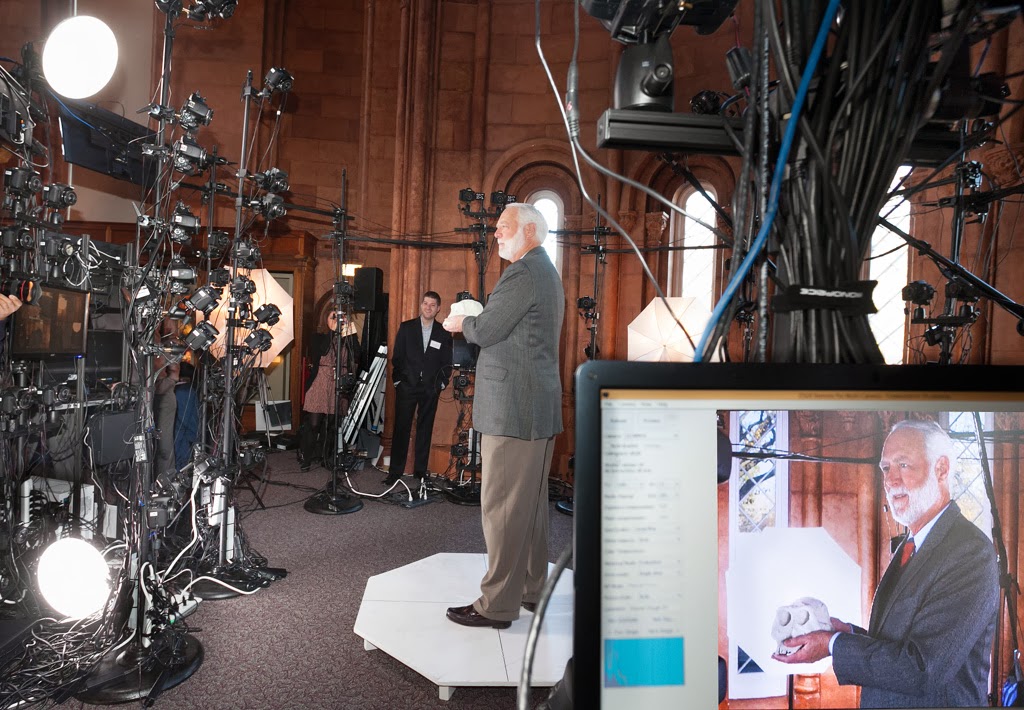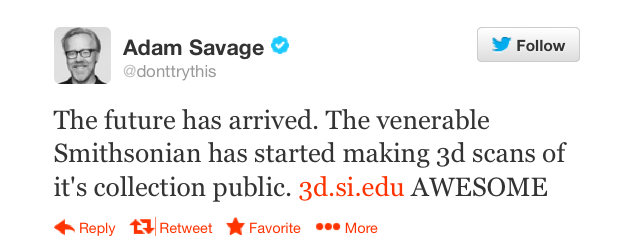
Last week I played hooky from writing TrendsWatch 2014 to catch up on one of our 2013 picks: 3D scanning and printing. The Smithsonian X 3D conference featured speakers from around the world sharing the latest developments in this rapidly evolving field. Today on the Blog, Günter Waibel, director, digitization program office, Smithsonian Institution, shares new of the biggest announcement at the conference—the Smithsonian’s launch of a new online digital tool. You can access the full archived webcast of the conference here.
Last week, the Smithsonian announced the availability of 20+ collections objects and scientific missions in an online 3D explorer which allows the public to rotate 3D models, manipulate them and take measurement. In addition, raw datasets of most models are available for educational and non-commercial use, and support further investigation in dedicated software packages as well as 3D printing.
Models include iconic Smithsonian collection treasures such as the 1903 Wright Flyer, the Gunboat Philadelphia, Amelia Earhart’s Flight Suit and Lincoln’s Life Masks, as well as scientific missions uncovering Fossil Whales in the Atacama desert, and a scan of the cave in Indonesia where the Hobbit Man (“Homo floresiensis”) was found. We called the launch event, as well as the ongoing activity, “Smithsonian X 3D” (#SIx3D) because we wanted to evoke the marvel of a 167 year old museum complex going head-to-head with the most cutting edge 21st century technology; and we wanted to state our premise that 3D technology would somehow multiply or amplify the Smithsonian in our ability to execute on our time-honored mission of the increase and diffusion of knowledge.
 |
| Smithsonian Secretary Dr. Clough getting 3D captured in the SIx3D Tech Gallery (photo: Eric Long, Smithsonian) |
 |
| Holding a 3D print of himself the following day. |
We have rigorously tested that premise over the last two years to make sure that we’re not adopting technology for technology’s sake, but because it furthers long-held Smithsonian ambitions. A crucial part of our test was to steep many of the Smithsonian’s 19 museums in 3D technology by asking them to nominate a compelling capture project, and then working with them to explore the implications of the 3D data set. In the course of this exploration, we’ve worked with curators found that the 3D dataset allowed them to see an object with new eyes, and make new discoveries; and with educators who are eager to get museum collection objects into the classroom—not as photographs, but as 3D prints!
This exploration also led us to experiment with a range of capture technologies, from lasers scanning to microCT to photogrammetry, as well as a variety of items that begins to reflect the mind boggling diversity of the Smithsonian’s 137 million object collection. We’ve captured things that fly such as an airplane and a bee; things that swim such as a boat and a whale; and things that walk (or crawl) such as a mammoth and a crab. We’ve captured entire research sites, and (not to brag) an entire SuperNova, courtesy of our colleagues at the Smithsonian Astrophysical Observatory. Defying easy categorization, we’ve also captured a garment, a chair, a mask, a sculpture, a flower and much more. And, of course, all of these items, being in the Smithsonian collection, have a one-of-a-kind story.
Take a tour of the 1903 Wright Flyer with Peter Jakab, associate director and chief curator, National Air & Space Museum
These one-of-a-kind stories are now more accessible than ever, thanks to the 3D explorer our sponsor Autodesk donated to this effort. The 3D explorer lets the public see an object from all angles; direct three different lightsources to get a better view of details; and use cross-sections to peer into the inside of an object (data permitting.). Moreover, the 3D explorer turns the models into a scaffold for story-telling. Curators, scientists and educators can draw a viewer’s attention to specific details of the model, while helping them understand what they are looking at through short essays and additional visuals. Just like a YouTube video, the 3D explorer models are “embeddable”—just grab the embed-code, and you can bring the model to life on your website or blog as we have done throughout this post.
We believe that Smithsonian X 3D projects indicate that this new technology has the potential not only to support the Smithsonian mission, but to transform museums’ mcore functions. Researchers working in the field may not come back with specimens, but with 3D data documenting a site or a find. Curators and educators can use 3D data as the scaffolding to tell stories or send students on a quest of discovery. Conservators can benchmark today’s condition state of a collection item against a past state—a deviation analysis of 3D data will tell them exactly what changes have occurred. While these use cases appear remarkable and extraordinary today, all of them are substantiated by Smithsonian X 3D projects, and all of them may represent the ordinary museum of tomorrow.
We think of the launch of Smithsonian X 3D as yet another step towards a new contract between the Smithsonian and the world which moves us beyond just letting people see (but not touch!) towards sparking interaction, creation, and learning by doing. It looks like we struck a nerve. In the 5 days after the launch, the new 3d.si.edu website received close to 100,000 unique visitors, which equaled the number of unique visitors for the Smithsonian homepage during that same period, while a 30% longer average visit duration and a 50% lower bounce rate testify to how engaging this content is. We had a total of 35 million impressions on Twitter for “Smithsonian 3D”, with 16 million accounts reached on the two days of the Smithsonian X 3D conference. Adam Savage of Mythbuster-fame led the charge by tweeting to his over 1 million followers:
Some of the initial uses of the data we’ve made available for download seems to suggest that we are reaching the younger audience that museums traditionally have difficulty with—witness the posts on i09 (convenient tagline: “we come from the future”), where one excited comment includes a new rendering of one of the Smithsonian models we released, placing the Wooly Mammoth back in its ice-age habitat.
 |
| Posted the day after Smithsonian X 3D launched, this renders the Wooly Mammoth back into its ice-age habitat. |
To learn more, please check out some of the Smithsonian X 3D videos, which bring many Smithsonian voices from curators, researchers, educators and conservators into a conversation about 3D in museums.
You can read more about the Smithsonian Digitization Office here, and follow the authors of this post via Twitter. Günter Waibel is @guwa, Adam Metallo, 3D program officer, digitization program office, Smithsonian Institution (@3D_Digi_SI), and Vincent Rossi, 3D program officer, digitization program office, Smithsonian Institution (@3D_Digi_SI).









